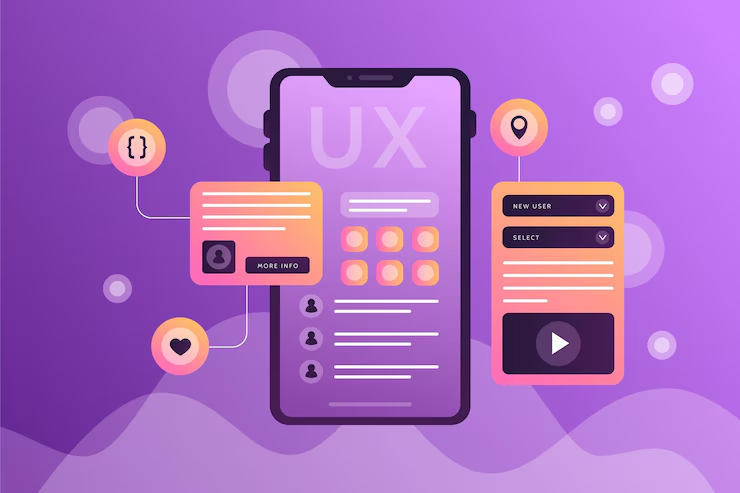Building Responsive UI in Flutter for All Devices focuses on creating layouts that adapt seamlessly to different screen sizes and orientations. Flutter’s flexible widgets like LayoutBuilder, MediaQuery, and Flexible make it easy to build adaptive UIs. This ensures a consistent user experience across mobiles, tablets, and desktops. Responsive design improves usability and accessibility for diverse users. It’s essential for modern apps targeting multiple platforms with a single codebase.
Mastering MediaQuery in Flutter for Responsive Layouts
MediaQuery is the key to understanding screen dimensions in Flutter. This blog explains how to use it to adjust font sizes, padding, and layout dynamically. Learn how to build UIs that adapt to different screen sizes with ease. We’ll walk through examples for mobile, tablet, and web. Discover when and where to use MediaQuery wisely. Ideal for beginners aiming for device flexibility.
Using LayoutBuilder to Build Adaptive Widgets
LayoutBuilder gives you the size of the widget’s parent, which is perfect for responsive design. This guide shows how to create flexible UIs that change based on available space. Build components that resize smartly on different devices. We’ll explore conditional layouts and how to handle constraints. LayoutBuilder is powerful for modular designs. A must-know tool in the Flutter UI toolkit.
Creating Breakpoints for Multi-Device Support in Flutter
Breakpoints help define when your layout should change — like switching from mobile to tablet UI. Learn how to create and use responsive breakpoints in Flutter. We provide a reusable breakpoint utility for clean design transitions. Make your apps feel natural across phones, tablets, and desktops. Breakpoints allow smart layout decisions. Improve UX with resolution-aware designs.
Responsive Grid and Column Layouts with Flutter
Grids are essential for structured responsive UIs. This post teaches you to build grid-based layouts using GridView, Wrap, and Flex. See how to control item spacing, count, and alignment across screen sizes. Great for product listings, portfolios, or dashboards. We include ready-to-use responsive grid snippets. Get full control of horizontal and vertical layout flows.
Flutter Responsive Design: Tips for Tablet Optimization
Designing for tablets requires more than just scaling up mobile layouts. This blog shares Flutter-specific tips to optimize UIs for tablets. We cover padding, layout changes, sidebars, and multi-pane views. Learn when to adapt or redesign views completely. Enhance UX for large screen devices. Avoid common pitfalls in tablet UI design.
Adaptive Navigation Patterns in Flutter
Navigation should also adapt based on screen size. Learn how to implement drawer navigation for mobile and side navigation for tablet/desktop in Flutter. We guide you through building adaptive navigation using NavigationRail, BottomNavigationBar, and Drawer. Improve user experience with intuitive flow. Flutter makes it easy with flexible widgets.
Using Flutter’s flutter_screenutil for Scalable UIs
flutter_screenutil is a popular package for making pixel-perfect, scalable UIs. This blog covers setup, usage, and real-world examples. Learn how to maintain consistent text sizes, spacing, and dimensions across devices. It simplifies responsive design drastically. We’ll show how to initialize and apply ScreenUtil globally. Make your designs truly resolution-independent.
Flutter Web Responsiveness: Designing for Desktop & Mobile
Web support in Flutter adds complexity to responsive design. This post helps you build interfaces that adapt to desktop, tablet, and mobile browsers. Learn how to design flexible widgets, handle pointer interactions, and adapt layouts. We provide desktop-friendly examples with flexible widths and margins. Flutter makes it possible to share UI across web and mobile with ease.
Building Responsive Dashboards in Flutter
Dashboards demand responsive widgets that rearrange and scale well. This blog walks through designing Flutter dashboards with side menus, dynamic grids, and cards. Learn to use LayoutBuilder, Expanded, and Flex efficiently. We cover widget hiding, wrapping, and adaptive alignment. Great for admin panels and analytics apps.
Responsive UI with Flutter’s Flexible and Expanded Widgets
Understanding Flexible and Expanded helps build stretchable UIs. This guide explains how to use them to adjust space distribution inside rows and columns. Learn to control widget proportions dynamically. Perfect for equal distribution or tight UI adjustments. We include live examples for real-world layouts. Gain full control over space management.
Creating Custom Widgets for Responsive Flutter Apps
Reusable widgets are essential in large-scale responsive apps. This blog teaches you how to create customizable widgets that adapt to screen size and orientation. Build scalable cards, containers, and text blocks. Encapsulate logic and styling for consistency. Make your code DRY and your UI reliable across form factors. Ideal for enterprise-grade apps.
Responsive Flutter Forms: Optimizing Inputs for All Devices
Forms are tricky to make responsive. This guide walks you through building adaptive forms with proper padding, field sizes, and keyboard handling. Learn to group inputs logically on large screens and stack them on small ones. We’ll show how to handle validation and responsiveness together. Make user input a breeze on any device.
Device Orientation Handling in Flutter UI Design
Orientation changes can break your layout if not handled properly. This blog explains how to detect and adapt UI based on device rotation. Build flexible layouts for portrait and landscape modes. Learn to use OrientationBuilder and design dual-pane interfaces. We also show how to lock or unlock orientation when needed. Improve experience on phones and tablets alike.
Using AspectRatio and FittedBox for Responsive Media
Handling images and videos responsively is important. Learn how AspectRatio and FittedBox can preserve content proportions across screens. We walk through image galleries, video players, and dynamic containers. Ensure your media doesn’t look stretched or clipped. Create polished UIs with media that scales beautifully.
Best Practices for Building Responsive Flutter Apps
This ultimate checklist wraps up key practices for responsive design in Flutter. From layout strategies to performance tips, we cover it all. Learn how to test on multiple devices and emulators. Avoid hard-coded sizes and embrace flexibility. Whether for mobile, tablet, or web — these practices ensure smooth user experiences everywhere.







